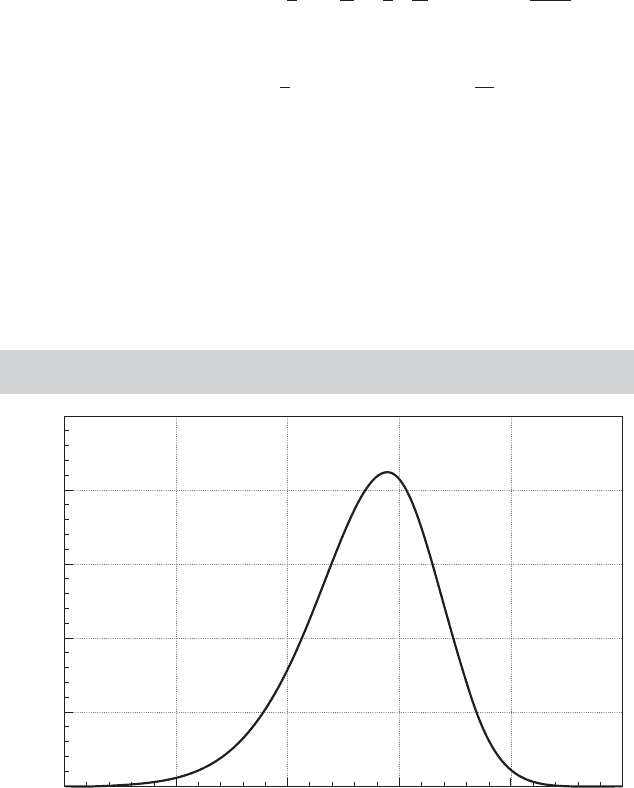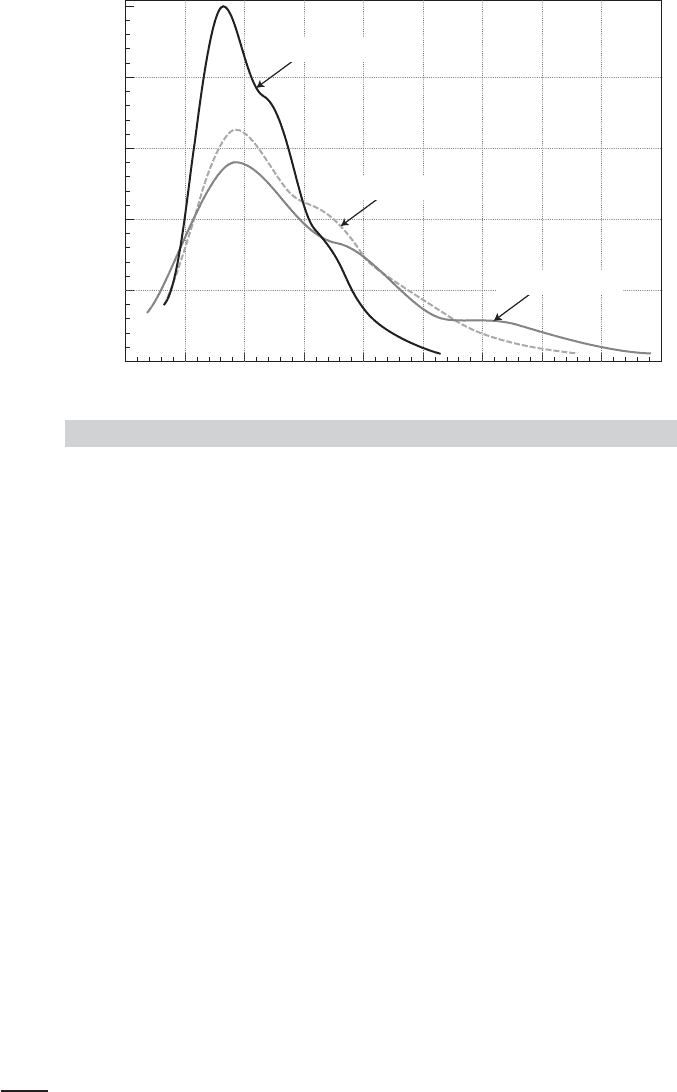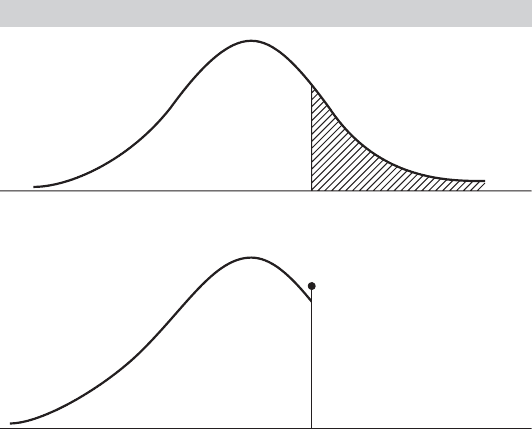Greene W.H. Econometric Analysis
Подождите немного. Документ загружается.


CHAPTER 19
✦
Limited Dependent Variables
839
which is a function of x
i
. If we estimate (19-10) by ordinary least squares regression of
y on X, then we have omitted a variable, the nonlinear term λ
i
. All the biases that arise
because of an omitted variable can be expected.
5
Without some knowledge of the distribution of x, it is not possible to determine
how serious the bias is likely to be. A result obtained by Chung and Goldberger
(1984) is broadly suggestive. If E [x | y] in the full population is a linear function of
y, then plim b = βτ for some proportionality constant τ . This result is consistent with
the widely observed (albeit rather rough) proportionality relationship between least
squares estimates of this model and maximum likelihood estimates.
6
The proportional-
ity result appears to be quite general. In applications, it is usually found that, compared
with consistent maximum likelihood estimates, the OLS estimates are biased toward
zero. (See Example 19.5.)
19.2.4 THE STOCHASTIC FRONTIER MODEL
A lengthy literature commencing with theoretical work by Knight (1933), Debreu
(1951), and Farrell (1957) and the pioneering empirical study by Aigner, Lovell, and
Schmidt (ALS, 1977) has been directed at models of production that specifically ac-
count for the textbook proposition that a production function is a theoretical ideal.
7
If
y = f (x) defines a production relationship between inputs, x, and an output, y, then for
any given x, the observed value of y must be less than or equal to f (x). The implication
for an empirical regression model is that in a formulation such as y = h(x, β) + u, u
must be negative. Because the theoretical production function is an ideal—the frontier
of efficient production—any nonzero disturbance must be interpreted as the result of in-
efficiency. A strictly orthodox interpretation embedded in a Cobb–Douglas production
model might produce an empirical frontier production model such as
ln y = β
1
+
k
β
k
ln x
k
− u, u ≥ 0.
The gamma model described in Example 4.7 was an application. One-sided distur-
bances such as this one present a particularly difficult estimation problem. The primary
theoretical problem is that any measurement error in ln y must be embedded in the
disturbance. The practical problem is that the entire estimated function becomes a slave
to any single errantly measured data point.
Aigner, Lovell, and Schmidt proposed instead a formulation within which observed
deviations from the production function could arise from two sources: (1) productive
inefficiency, as we have defined it earlier and that would necessarily be negative, and
(2) idiosyncratic effects that are specific to the firm and that could enter the model with
either sign. The end result was what they labeled the stochastic frontier:
ln y = β
1
+
k
β
k
ln x
k
− u + v, u ≥ 0,v∼ N
0,σ
2
v
.
= β
1
+
k
β
k
ln x
k
+ ε.
5
See Heckman (1979) who formulates this as a “specification error.”
6
See the appendix in Hausman and Wise (1977) and Greene (1983) as well.
7
A survey by Greene (2008a) appears in Fried, Lovell, and Schmidt (2008). Kumbhakar and Lovell (2000) is
a comprehensive reference on the subject.

840
PART IV
✦
Cross Sections, Panel Data, and Microeconometrics
The frontier for any particular firm is h(x, β)+v, hence the name stochastic frontier.The
inefficiency term is u, a random variable of particular interest in this setting. Because
the data are in log terms, u is a measure of the percentage by which the particular
observation fails to achieve the frontier, ideal production rate.
To complete the specification, they suggested two possible distributions for the in-
efficiency term: the absolute value of a normally distributed variable, which has the
truncated at zero distribution shown in Figure 19.1, and an exponentially distributed
variable. The density functions for these two compound variables are given by Aigner,
Lovell, and Schmidt; let ε = v − u,λ = σ
u
/σ
v
,σ = (σ
2
u
+ σ
2
v
)
1/2
, and (z) =the prob-
ability to the left of z in the standard normal distribution (see Section B.4.1). For the
“half-normal” model,
ln h(ε
i
|β,λ,σ) =
−ln σ +
1
2
ln
2
π
−
1
2
ε
i
σ
2
+ ln
−ε
i
λ
σ
,
whereas for the exponential model
ln h(ε
i
|β,θ,σ
v
) =
ln θ +
1
2
θ
2
σ
2
v
+ θε
i
+ ln
−
ε
i
σ
v
− θσ
v
.
Both these distributions are asymmetric. We thus have a regression model with a
nonnormal distribution specified for the disturbance. The disturbance, ε, has a nonzero
mean as well; E [ε] =−σ
u
(2/π)
1/2
for the half-normal model and −1/θ for the expo-
nential model. Figure 19.2 illustrates the density for the half-normal model with σ = 1
and λ = 2. By writing β
0
= β
1
+E [ε] and ε
∗
= ε −E [ε], we obtain a more conventional
formulation
ln y = β
0
+
k
β
k
ln x
k
+ ε
∗
,
FIGURE 19.2
Density for the Disturbance in the Stochastic Frontier
Model.
2.8 1.6
Density
0.4
0.8 2.04.0
0.00
0.70
0.56
0.42
0.28
0.14

CHAPTER 19
✦
Limited Dependent Variables
841
which does have a disturbance with a zero mean but an asymmetric, nonnormal distribu-
tion. The asymmetry of the distribution of ε
∗
does not negate our basic results for least
squares in this classical regression model. This model satisfies the assumptions of the
Gauss–Markov theorem, so least squares is unbiased and consistent (save for the con-
stant term) and efficient among linear unbiased estimators. In this model, however, the
maximum likelihood estimator is not linear, and it is more efficient than least squares.
The log-likelihood function for the half normal model is given in ALS (1977):
ln L =−n ln σ +
n
2
ln
2
π
−
1
2
n
i=1
ε
i
σ
2
+
n
i=1
ln
−ε
i
λ
σ
. (19-11)
Maximization programs for this model are built into modern software packages such as
Stata, NLOGIT, and TSP. The log-likelihood is simple enough that it can also be readily
adapted to the generic optimization routines in, for example, MatLab or Gauss. Some
treatments in the literature use the parameterization employed by Battese and Coelli
(1992) and Coelli (1996), γ = σ
2
u
/σ
2
. This is a one-to-one transformation of λ;λ =
(γ /(1 − γ))
1/2
, so which parameterization is employed is a matter of convenience; the
empirical results will be the same. The log-likelihood function for the exponential model
can be built up from the density given earlier. For the half-normal model, we would also
rely on the invariance of maximum likelihood estimators to recover estimates of the
structural variance parameters, σ
2
v
= σ
2
/(1 + λ
2
) and σ
2
u
= σ
2
λ
2
/(1 + λ
2
).
8
(Note, the
variance of the truncated variable,u
i
,isnotσ
2
u
; using (19-2), it reduces to (1−2/π)σ
2
u
].) In
addition, a structural parameter of interest is the proportion of the total variance of ε that
is due to the inefficiency term. For the half-normal model, Var[ε] = Var[u] + Var[v] =
(1 − 2/π)σ
2
u
+ σ
2
v
whereas for the exponential model, the counterpart is 1/θ
2
+ σ
2
v
.
Modeling in the stochastic frontier setting is rather unlike what we are accustomed
to up to this point, in that the disturbance, specifically u
i
, not the model parameters, is
the central focus of the analysis. The reason is that in this context, the disturbance, u
i
,
rather than being the catchall for the unknown and unknowable factors omitted from
the equation, has a particular interpretation—it is the firm-specific inefficiency. Ideally,
we would like to estimate u
i
for each firm in the sample to compare them on the basis
of their productive efficiency. Unfortunately, the data do not permit a direct estimate,
because with estimates of β in hand, we are only able to compute a direct estimate of
ε
i
= y
i
−x
i
β. Jondrow et al. (1982), however, have derived a useful approximation that
is now the standard measure in these settings,
E[u
i
|ε
i
] =
σλ
1 + λ
2
φ(z
i
)
1 − (z
i
)
− z
i
, z
i
=
ε
i
λ
σ
for the half-normal model, and
E[u
i
|ε
i
] = z
i
+ σ
v
φ(z
i
/σ
v
)
(z
i
/σ
v
)
, z
i
=−
ε
i
+ θσ
2
v
for the exponential model.These values can be computed using the maximum likelihood
estimates of the structural parameters in the model. In some cases in which researchers
8
A vexing problem for estimation of the model is that if the ordinary least squares residuals are skewed in
the positive (wrong) direction (See Figure 19.2), OLS with
ˆ
λ = 0 will be the MLE. OLS residuals with a
positive skew are apparently inconsistent with a model in which, in theory, they should have a negative skew.
[See Waldman (1982) for theoretical development of this result.]
842
PART IV
✦
Cross Sections, Panel Data, and Microeconometrics
are interested in discovering best practice [e.g., WHO (2000), Tandon et al. (2000)], the
estimated values are sorted and the ranks of the individuals in the sample become of
interest.
Research in this area since the methodological developments beginning in the 1930s
and the building of the empirical foundations in 1977 and 1982 has proceeded in several
directions. Most theoretical treatments of “inefficiency” as envisioned here attribute
it to aspects of management of the firm. It remains to establish a firm theoretical con-
nection between the theory of firm behavior and the stochastic frontier model as a
device for measurement of inefficiency.
In the context of the model, many studies have developed alternative, more flexible
functional forms that (it is hoped) can provide a more realistic model for inefficiency.
Two that are relevant in this chapter are Stevenson’s (1980) truncated normal model
and the normal-gamma frontier. One intuitively appealing form of the truncated normal
model is
U
i
∼ N
μ + z
i
α,σ
2
u
,
u
i
=|U
i
|.
The original normal–half-normal model results if μ equals zero and α equals zero. This
is a device by which the environmental variables noted in the next paragraph can enter
the model of inefficiency. A truncated normal model is presented in Example 19.3. The
half-normal, truncated normal, and exponential models all take the form of distribution
shown in Figure 19.1. The gamma model,
f (u) = [θ
P
/(P)] exp(−θ u)u
P−1
,
is a flexible model that presents the advantage that the distribution of inefficiency
can move away from zero. If P is greater than one, then the density at u = 0 equals
zero and the entire distribution moves away from the origin. The implication is that
the distribution of inefficiency among firms can move away from zero. The gamma
model is estimated by simulation methods—either Bayesian MCMC [Huang (2003)
and Tsionas (2002)] or maximum simulated likelihood [Greene (2003)]. Many other
functional forms have been proposed. [See Greene (2008) for a survey.]
There are usually elements in the environment in which the firm operates that
impact the firm’s output and/or costs but are not, themselves, outputs, inputs, or input
prices. In Example 19.3, the costs of the Swiss railroads are affected by three variables;
track width, long tunnels, and curvature. It is not yet specified how such factors should be
incorporated into the model; four candidates are in the mean and variance of u
i
, directly
in the function, or in the variance of v
i
. [See Hadri, Guermat, and Whittaker (2003) and
Kumbhakar (1997c).] All of these can be found in the received studies. This aspect of
the model was prominent in the discussion of the famous World Health Organization
efficiency study of world health systems [WHO (2000), Tandon, Murray, Lauer, and
Evans (2000), and Greene (2004)]. In Example 19.3, we have placed the environmental
factors in the mean of the inefficiency distribution. This produces a rather extreme
set of results for the JLMS estimates of inefficiency—many railroads are estimated
to be extremely inefficient. An alternative formulation would be a “heteroscedastic”
model in which σ
u,i
= σ
u
exp(z
i
δ) or σ
v,i
= σ
v
exp(z
i
η), or both. We can see from the
JLMS formula that the term heteroscedastic is actually a bit misleading, since both
CHAPTER 19
✦
Limited Dependent Variables
843
standard deviations enter (now) λ
i
, which is, in turn, a crucial parameter in the mean
of inefficiency.
How should inefficiency be modeled in panel data, such as in our example? It
might be tempting to treat it as a time-invariant “effect” [as in Schmidt and Sickles
(1984) and Pitt and Lee (1984) in two pioneering papers]. Greene (2004) argued that a
preferable approach would be to allow inefficiency to vary freely over time in a panel,
and to the extent that there is a common time-invariant effect in the model, that should
be treated as unobserved heterogeneity, not inefficiency. A string of studies, including
Battese and Coelli (1992, 1995), Cuesta (2000), Kumbhakar (1997a) Kumbhakar and
Orea (2004), and many others have proposed hybrid forms that treat the core random
part of inefficiency as a time-invariant firm-specific effect that is modified over time by
a deterministic, possibly firm-specific, function. The Battese-Coelli form,
u
it
= exp[−η(t − T)]|U
i
| where U
i
N
0,σ
2
u
,
has been used in a number of applications. Cuesta (2000) suggests allowing η to vary
across firms, producing a model that bears some relationship to a fixed-effects specifi-
cation. This thread of the literature is one of the most active ongoing pursuits.
Is it reasonable to use a possibly restrictive parametric approach to modeling in-
efficiency? Sickles (2005) and Kumbhakar, Simar, Park, and Tsionas (2007) are among
numerous studies that have explored less parametric approaches to efficiency analysis.
Proponents of data envelopment analysis [see, e.g., Simar and Wilson (2000, 2007)] have
developed methods that impose absolutely no parametric structure on the production
function. Among the costs of this high degree of flexibility is a difficulty to include envi-
ronmental effects anywhere in the analysis, and the uncomfortable implication that any
unmeasured heterogeneity of any sort is necessarily included in the measure of ineffi-
ciency. That is, data envelopment analysis returns to the deterministic frontier approach
where this section began.
Example 19.3 Stochastic Cost Frontier for Swiss Railroads
Farsi, Filippini, and Greene (2005) analyzed the cost efficiency of Swiss railroads. In order to
use the stochastic frontier approach to analyze costs of production, rather than production,
we rely on the fundamental duality of production and cost [see Samuelson (1938), Shephard
(1953), and Kumbhakar and Lovell (2000)]. An appropriate cost frontier model for a firm that
produces more than one output—the Swiss railroads carry both freight and passengers—will
appear as the following:
ln(C/P
K
) = α +
K −1
k=1
β
k
ln( P
k
/P
K
) +
M
m=1
γ
m
ln Q
m
+ v + u.
The requirement that the cost function be homogeneous of degree one in the input prices
has been imposed by normalizing total cost, C, and the first K −1 prices by the K th input
price. In this application, the three factors are labor, capital, and electricity—the third is
used as the numeraire in the cost function. Notice that the inefficiency term, u, enters the
cost function positively; actual cost is above the frontier cost. [The MLE is modified simply by
replacing ε
i
with −ε
i
in (19-11).] In analyzing costs of production, we recognize that there is an
additional source of inefficiency that is absent when we analyze production. On the production
side, inefficiency measures the difference between output and frontier output, which arises
because of technical inefficiency. By construction, if output fails to reach the efficient level
for the given input usage, then costs must be higher than frontier costs. However, costs can
be excessive even if the firm is technically efficient if it is “allocatively inefficient.” That is, the
firm can be technically efficient while not using inputs in the cost minimizing mix (equating

844
PART IV
✦
Cross Sections, Panel Data, and Microeconometrics
the ratio of marginal products to the input price ratios). It follows that on the cost side, “u”
can contain both elements of inefficiency while on the production side, we would expect to
measure only technical inefficiency. [See Kumbhakar (1997b).]
The data for this study are an unbalanced panel of 50 railroads with T
i
ranging from 1
to 13. (Thirty-seven of the firms are observed 13 times, 8 are observed 12 times, and the
remaining 5 are observed 10, 7, 7, 3, and 1 times.) The variables we will use here are
CT: Total costs adjusted for inflation (1,000 Swiss franc)
QP: Total passenger-output in passenger-kilometers
QF: Total goods-output in ton-kilometers
PL: Labor price adjusted for inflation (in Swiss Francs per person per year)
PK: Capital price with capital stock proxied by total number of seats
PE: Price of electricity (Swiss franc per kWh)
Logs of costs and prices (ln CT,lnPK,lnPL) are normalized by PE. We will also use these
environmental variables:
NARROW
T: Dummy for the networks with narrow track (1 m wide) The usual
width is 1.435m.
TUNNEL: Dummy for networks that have tunnels with an average length
of more than 300 meters.
VIRAGE: Dummy for the networks whose minimum radius of curvature is
100 meters or less.
The full data set is given in Appendix Table F19.1. Several other variables not used here are
presented in the appendix table. In what follows, we will ignore the panel data aspect of the
data set. This would be a focal point of a more extensive study.
There have been dozens of models proposed for the inefficiency component of the
stochastic frontier model. Table 19.1 presents several different forms. The basic half-normal
model is given in the first column. The estimated cost function parameters across the different
TABLE 19.1
Estimated Stochastic Frontier Cost Functions
a
Model
Half Truncated
Variable Normal Normal Exponential Gamma Heterosced Heterogen
Constant −10.0799 −9.80624 −10.1838 −10.1944 −9.82189 −10.2891
ln QP 0.64220 0.62573 0.64403 0.64401 0.61976 0.63576
ln QF 0.06904 0.07708 0.06803 0.06810 0.07970 0.07526
ln PK 0.26005 0.26625 0.25883 0.25886 0.25464 0.25893
ln PL 0.53845 0.50474 0.56138 0.56047 0.53953 0.56036
Constant 0.44116 −2.48218
b
Narrow 0.29881 2.16264
b
0.14355
Virage −0.20738 −1.52964
b
−0.10483
Tunnel 0.01118 0.35748
b
−0.01914
σ 0.44240 0.38547 (0.34325) (0.34288) 0.45392
c
0.40597
λ 1.27944 2.35055 0.91763
P 1.0000 1.22920
θ 13.2922 12.6915
σ
u
(0.34857) (0.35471) (0.07523) (0.09685) 0.37480
c
0.27448
σ
v
(0.27244) (0.15090) 0.33490 0.33197 0.25606 0.29912
Mean E[u|ε] 0.27908 0.52858 0.075232 0.096616 0.29499 0.21926
ln L −210.495 −200.67 −211.42 −211.091 −201.731 −208.349
a
Estimates in parentheses are derived from other MLEs.
b
Estimates used in computation of σ
u
.
c
Obtained by averaging λ = σ
u,i
/σ
v
over observations.

CHAPTER 19
✦
Limited Dependent Variables
845
0.00 0.10 0.20 0.30 0.40 0.50 0.60 0.70 0.80 0.90
0.00
1.02
2.04
3.06
Density
4.08
5.10
Inefficiency
Heterogeneous
Half-Normal
Heteroscedastic
FIGURE 19.3
Kernel Density Estimator for JLMS Estimates.
forms are broadly similar, as might be expected as (α, β) are consistently estimated in all
cases. There are fairly pronounced differences in the implications for the components of ε,
however.
There is an ambiguity in the model as to whether modifications to the distribution of u
i
will affect the mean of the distribution, the variance, or both. The following results suggest
that it is both for these data. The gamma and exponential models appear to remove most
of the inefficiency from the data. Note that the estimates of σ
u
are considerably smaller
under these specifications, and σ
v
is correspondingly larger. The second to last row shows
the sample averages of the Jondrow estimators—this estimates E
ε
E[u|ε] = E[u]. There is
substantial difference across the specifications.
The estimates in the rightmost two columns illustrate two different placements of the mea-
sured heterogeneity: in the variance of u
i
and directly in the cost function. The log-likelihood
function appears to favor the first of these. However, the models are not nested and involve
the same number of parameters. We used the Vuong test (see Section 14.6.6), instead and
obtained a value of −2.65 in favor of the heteroscedasticity model. Figure 19.3 describes the
values of E[u
i
|ε
i
] estimated for the sample observations for the half-normal, heteroscedastic
and heterogeneous models. The smaller estimate of σ
u
for the third of these is evident in the
figure, which suggests a somewhat tighter concentration of values than the other two.
19.3 CENSORED DATA
A very common problem in microeconomic data is censoring of the dependent variable.
When the dependent variable is censored, values in a certain range are all transformed
to (or reported as) a single value. Some examples that have appeared in the empirical
literature are as follows:
9
1. Household purchases of durable goods [Tobin (1958)]
2. The number of extramarital affairs [Fair (1977, 1978)]
9
More extensive listings may be found in Amemiya (1984) and Maddala (1983).

846
PART IV
✦
Cross Sections, Panel Data, and Microeconometrics
3. The number of hours worked by a woman in the labor force [Quester and Greene
(1982)]
4. The number of arrests after release from prison [Witte (1980)]
5. Household expenditure on various commodity groups [Jarque (1987)]
6. Vacation expenditures [Melenberg and van Soest (1996)]
Each of these studies analyzes a dependent variable that is zero for a significant frac-
tion of the observations. Conventional regression methods fail to account for the
qualitative difference between limit (zero) observations and nonlimit (continuous)
observations.
19.3.1 THE CENSORED NORMAL DISTRIBUTION
The relevant distribution theory for a censored variable is similar to that for a truncated
one. Once again, we begin with the normal distribution, as much of the received work
has been based on an assumption of normality. We also assume that the censoring point
is zero, although this is only a convenient normalization. In a truncated distribution,
only the part of distribution above y = 0 is relevant to our computations. To make the
distribution integrate to one, we scale it up by the probability that an observation in
the untruncated population falls in the range that interests us. When data are censored,
the distribution that applies to the sample data is a mixture of discrete and continuous
distributions. Figure 19.4 illustrates the effects.
To analyze this distribution, we define a new random variable y transformed from
the original one, y
∗
,by
y = 0ify
∗
≤ 0,
y = y
∗
if y
∗
> 0.
FIGURE 19.4
Partially Censored Distribution.
Capacity Seats demanded
Capacity Tickets sold

CHAPTER 19
✦
Limited Dependent Variables
847
The distribution that applies if y
∗
∼ N[μ, σ
2
] is Prob(y = 0) = Prob(y
∗
≤ 0) =
(−μ/σ ) = 1 −(μ/σ ), and if y
∗
> 0, then y has the density of y
∗
.
This distribution is a mixture of discrete and continuous parts. The total probability
is one, as required, but instead of scaling the second part, we simply assign the full
probability in the censored region to the censoring point, in this case, zero.
THEOREM 19.3
Moments of the Censored Normal Variable
If y
∗
∼ N[μ, σ
2
] and y = aify
∗
≤ a or else y = y
∗
, then
E [y] = a + (1 − )(μ + σ λ),
and
Var[y] = σ
2
(1 − )[(1 − δ) + (α − λ)
2
],
where
[(a − μ)/σ ] = (α) = Prob(y
∗
≤ a) = , λ = φ/(1 − ),
and
δ = λ
2
− λα.
Proof: For the mean,
E [y] = Prob(y = a) × E [y | y = a] + Prob(y > a) × E [y | y > a]
= Prob(y
∗
≤ a) × a + Prob(y
∗
> a) × E [y
∗
| y
∗
> a]
= a + (1 − )(μ + σλ)
using Theorem 19.2. For the variance, we use a counterpart to the decomposition
in (B-69), that is, Var[y] = E [conditional variance] + Var[conditional mean],
and Theorem 19.2.
For the special case of a = 0, the mean simplifies to
E [y |a = 0] = (μ/σ )(μ + σλ), where λ =
φ(μ/σ )
(μ/σ )
.
For censoring of the upper part of the distribution instead of the lower, it is only neces-
sary to reverse the role of and 1 − and redefine λ as in Theorem 19.2.
Example 19.4 Censored Random Variable
We are interested in the number of tickets demanded for events at a certain arena. Our only
measure is the number actually sold. Whenever an event sells out, however, we know that the
actual number demanded is larger than the number sold. The number of tickets demanded
is censored when it is transformed to obtain the number sold. Suppose that the arena in
question has 20,000 seats and, in a recent season, sold out 25 percent of the time. If the
average attendance, including sellouts, was 18,000, then what are the mean and standard
deviation of the demand for seats? According to Theorem 19.3, the 18,000 is an estimate of
E[sales] = 20,000( 1 − ) + [μ + σλ].
Because this is censoring from above, rather than below, λ =−φ ( α)/( α) . The argu-
ment of , φ, and λ is α = (20,000 − μ) /σ . If 25 percent of the events are sellouts, then
= 0.75. Inverting the standard normal at 0.75 gives α = 0.675. In addition, if α = 0.675,

848
PART IV
✦
Cross Sections, Panel Data, and Microeconometrics
then −φ(0.675)/0.75 = λ =−0.424. This result provides two equations in μ and σ , (a)
18,000 = 0.25( 20,000) + 0.75(μ − 0.424σ ) and (b) 0.675σ = 20,000 − μ. The solutions are
σ = 2426 and μ = 18,362.
For comparison, suppose that we were told that the mean of 18,000 applies only to the
events that were not sold out and that, on average, the arena sells out 25 percent of the
time. Now our estimates would be obtained from the equations (a) 18,000 = μ −0.424σ and
(b) 0.675σ = 20,000 − μ. The solutions are σ = 1820 and μ = 18,772.
19.3.2 THE CENSORED REGRESSION (TOBIT) MODEL
The regression model based on the preceding discussion is referred to as the censored
regression model or the tobit model [in reference to Tobin (1958), where the model
was first proposed]. The regression is obtained by making the mean in the preceding
correspond to a classical regression model. The general formulation is usually given in
terms of an index function,
y
∗
i
= x
i
β + ε
i
,
y
i
= 0ify
∗
i
≤ 0,
y
i
= y
∗
i
if y
∗
i
> 0.
There are potentially three conditional mean functions to consider, depending on the
purpose of the study. For the index variable, sometimes called the latent variable,
E [y
∗
i
|x
i
]isx
i
β. If the data are always censored, however, then this result will usu-
ally not be useful. Consistent with Theorem 19.3, for an observation randomly drawn
from the population, which may or may not be censored,
E [y
i
|x
i
] =
x
i
β
σ
(x
i
β + σλ
i
),
where
λ
i
=
φ[(0 − x
i
β)/σ ]
1 − [(0 − x
i
β)/σ ]
=
φ(x
i
β/σ )
(x
i
β/σ )
. (19-12)
Finally, if we intend to confine our attention to uncensored observations, then the re-
sults for the truncated regression model apply. The limit observations should not be
discarded, however, because the truncated regression model is no more amenable to
least squares than the censored data model. It is an unresolved question which of these
functions should be used for computing predicted values from this model. Intuition
suggests that E [y
i
|x
i
] is correct, but authors differ on this point. For the setting in
Example 19.4, for predicting the number of tickets sold, say, to plan for an upcoming
event, the censored mean is obviously the relevant quantity. On the other hand, if the
objective is to study the need for a new facility, then the mean of the latent variable y
∗
i
would be more interesting.
There are differences in the partial effects as well. For the index variable,
∂E [y
∗
i
|x
i
]
∂x
i
= β.
But this result is not what will usually be of interest, because y
∗
i
is unobserved. For the
observed data, y
i
, the following general result will be useful:
10
10
See Greene (1999) for the general result and Rosett and Nelson (1975) and Nakamura and Nakamura
(1983) for applications based on the normal distribution.
